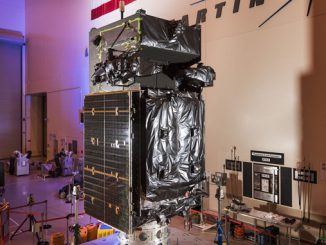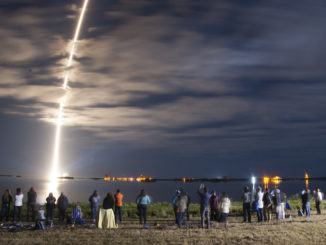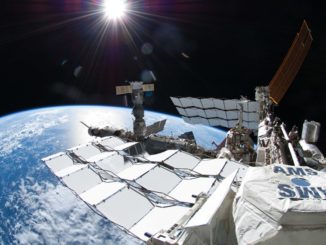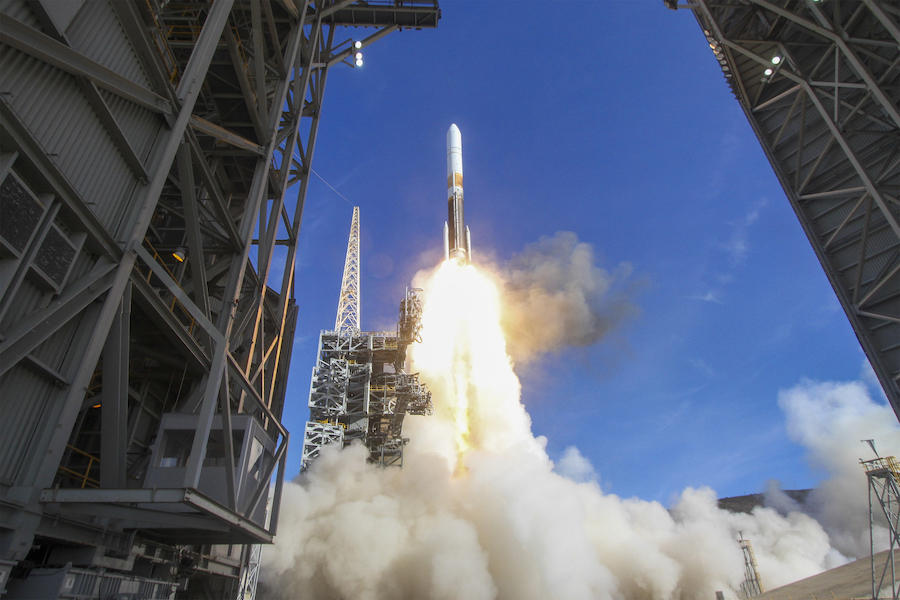
A United Launch Alliance Delta 4 rocket climbed into orbit Friday from Vandenberg Air Force Base in California with a top secret spy satellite, adding a new set of eyes in the sky for the U.S. government’s intelligence community and nudging part of the Delta 4 family closer to retirement.
The 217-foot-tall (66-meter) Delta 4 rocket lifted off at 2:11 p.m. PST (5:11 p.m. EST; 2211 GMT) from Space Launch Complex 6 at Vandenberg on the power of an Aerojet Rocketdyne RS-68A main engine and two Orbital ATK-built solid rocket boosters.
The RS-68A engine ignited with a burst of orange flame, spinning up its pumps to consume super-cold liquid hydrogen and liquid oxygen for a four-minute firing.
Two side-mounted solid rocket boosters fired as the countdown clock ticked down to zero, combining with the RS-68A main engine to send the Delta 4 away from the historic SLC-6 launch pad atop 1.2 million pounds of thrust.
The Delta 4 arced to the southwest over the Pacific Ocean, surpassing the speed of sound in less than a minute and dropping its two spent solid rocket boosters after burnout around 90 seconds into the flight.
The rocket’s nose shroud, which cocooned the top secret National Reconnaissance Office payload in the early phase of launch, jettisoned from the Delta 4 moments after it passed the mission’s three-minute point.
ULA’s live webcast of the launch ended after the fairing’s jettison, and the rest of the flight occurred in a news blackout.
The Delta 4’s first stage was expected to end its burn around four minutes after liftoff, then the rocket’s second stage RL10 engine was programmed to complete the job of placing the clandestine payload in orbit.
ULA confirmed the flight’s successful outcome in a press release around two hours after liftoff.
“As the nation’s most trustworthy launch provider, today’s launch exemplifies ULA’s ongoing commitment to 100 percent mission success,” said Will Crawford, ULA’s NRO program manager. “My sincere thanks to the entire ULA team and our mission partners at the NRO and U.S. Air Force who made this, our 27th NRO launch, possible.”
The launch was delayed from December to allow engineers to complete checks of a new avionics package that flew for the firt time on a Delta 4. ULA’s “common avionics” system is designed to fly on both of the company’s workhorse rockets — the Atlas 5 and Delta 4 — to reduce manpower and costs for each mission.
The common avionics upgrade has flown several times on Atlas 5 rockets before its debut on Delta 4 on Friday.
“This is the first Delta 4 that we’ve launched out of Vandenberg with common avionics,” said Maj. Allen Varghese, the Air Force’s launch director for the NROL-47 mission and director of operations at the 4th Space Launch Squadron. “Common avionics is a major, multi-year effort to standardize avionics across the ULA fleet for Atlas and Delta. It streamlines hardware and launch day operations,
High winds at Vandenberg prevented launch Wednesday, and several technical problems halted a countdown Thursday.
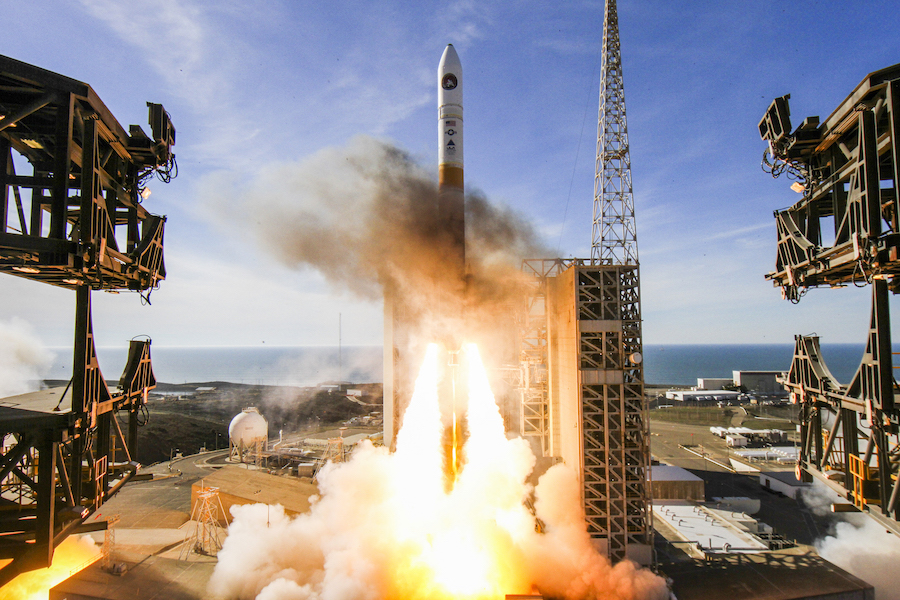
“We are very happy to begin the new year with a successful launch,” said Col. Matthew Skeen, director of the NRO’s Office of Space Launch. “As with every launch, our success is rooted in teamwork, and we would not be able to do what we do without our government and industry team members.”
“We are grateful for their continued drive to get our critical assets on orbit and their commitment and dedication to our national security mission,” Skeen said.
“It’s a classified payload for the NRO,” Varghese said in a pre-launch interview. “We can’t go into the details of what the payload does, but it’s a national security priority, and it’s mission will ensure that the warfighters across the globe have the appropriate intel that they need to be able to support operations.”
Codenamed NROL-47, the satellite lofted Friday will likely join the NRO’s fleet of orbiting radar reconnaissance stations.
The Delta 4’s trajectory toward the southwest suggested it was bound for an unusual high-inclination retrograde orbit that would allow the rocket’s top secret payload to travel in the opposite direction of Earth’s rotation.
The NRO’s Topaz radar surveillance satellites gather all-weather, day-and-night imagery for analysis by U.S. intelligence agencies. Previous Delta 4s believed to carry NRO radar reconnaissance craft used the same “5,2” configuration of the rocket, with a 5-meter (16-foot) diameter payload fairing and two solid rocket boosters, and the rockets also arced to the southwest from Vandenberg during missions in 2012 and 2016.
Two other Topaz satellites are believed by analysts to have launched on Atlas 5 rockets in 2010 and 2013.
But hazard notices released to mariners and pilots suggested the Delta 4 launching Friday would take a slightly different path, raising questions whether the payload has a different design or function than the NRO’s other Topaz radar spy satellites, according to Marco Langbroek, a experienced amateur satellite tracker who lives in the Netherlands.
The other Topaz satellites went into 685-mile-high (1,100-kilometer) orbits tilted 123 degrees to Earth’s equator, while NROL-47’s track appeared to take it into a slightly higher, 108.6-degree inclination orbit.
But the the jury is out on NROL-47’s orbit, and a network of amateur satellite trackers will attempt to find the spacecraft based on pre-launch orbital predictions.
The Topaz satellites are built by Boeing and were originally developed for the NRO’s Future Imagery Architecture program. The radar spy satellites work in conjunction with the NRO’s optical surveillance craft, which carry telescopic cameras to look down on Earth.
Radars have the benefit of seeing the ground at night and through clouds, revealing structures hidden under the cloak of darkness or camouflaged from conventional cameras.
The Topaz satellites follow the NRO’s previous generation of radar satellites, known as the Lacrosse fleet. While the Lacrosse satellites orbited at two different inclinations moving in the same direction as Earth’s rotation, the Topaz craft fly in retrograde orbits.
The reason for the change in orbits remains a mystery.
“Considering that Lacrosse operated in two different orbital inclinations, it may be that FIA Radar is about to do likewise with the payload of NROL-47,” said Ted Molczan, an experienced satellite tracker who lives in Canada. “Another possibility is that the payload of NROL-47 is a new generation of radar, intended to operate at a lower inclination.
“If and when (NROL-47) is found, analysis of its orbit may offer clues regarding its mission and possible relationship to FIA Radar,” he said.
Friday’s launch was the 36th flight of a Delta 4 rocket since 2002, and the seventh from Vandenberg.
It was the last launch of a medium-lift, single-core version of the Delta 4 rocket from Vandenberg Air Force Base. ULA is retiring the “single-stick” Delta 4 family in favor of the less expensive Atlas 5, before eventually replacing both rockets with the next-generation Vulcan launcher.
Two more single-core Delta 4s are slated to launch from Cape Canaveral.
The heavy-lift version of the Delta 4, comprising three of the rocket’s first stages bolted together, will remain in service through at least the early 2020s to deploy the NRO’s most massive satellites. Those payloads weigh too much for the Atlas 5 or SpaceX’s Falcon 9 rocket, the two other launch vehicles currently certified to haul costly U.S. military and intelligence-gathering satellites into orbit.
The next flight by ULA is scheduled for next week, when an Atlas 5 rocket will blast off Jan. 18 from Cape Canaveral with the Air Force’s fourth SBIRS early warning satellite toward geostationary orbit more than 22,000 miles (nearly 36,000 miles) over the equator.
Three more Delta 4s are set for launch this year. The next one is scheduled for liftoff from Cape Canaveral on July 31 with NASA’s Parker Solar Probe, using the triple-core Delta 4-Heavy configuration.
Two more Delta 4 missions are slated late this year: a Delta 4-Heavy from Vandenberg with another classified NRO satellite, and a Delta 4-Medium from Cape Canaveral with the Air Force’s tenth WGS communications craft.
Email the author.
Follow Stephen Clark on Twitter: @StephenClark1.

